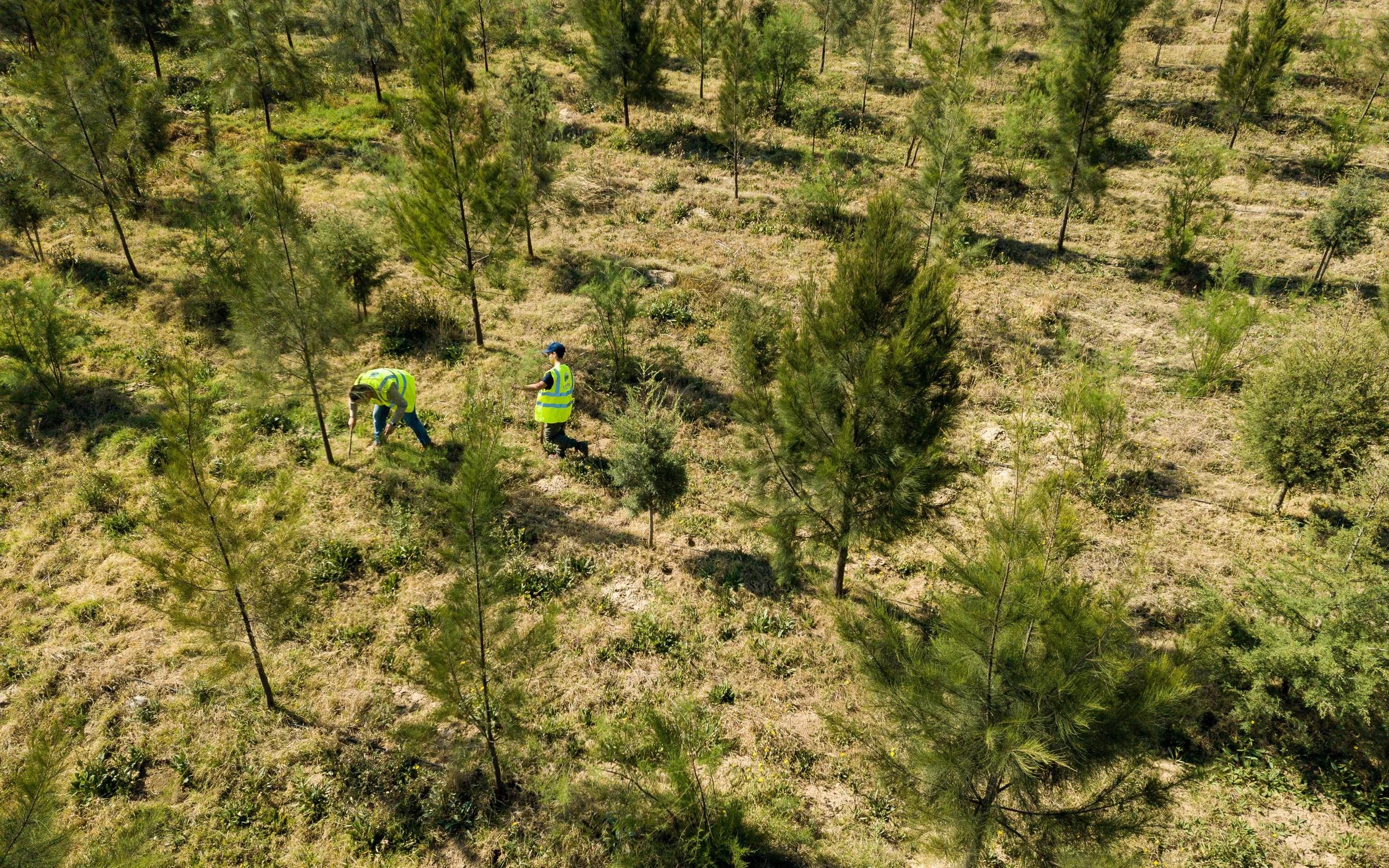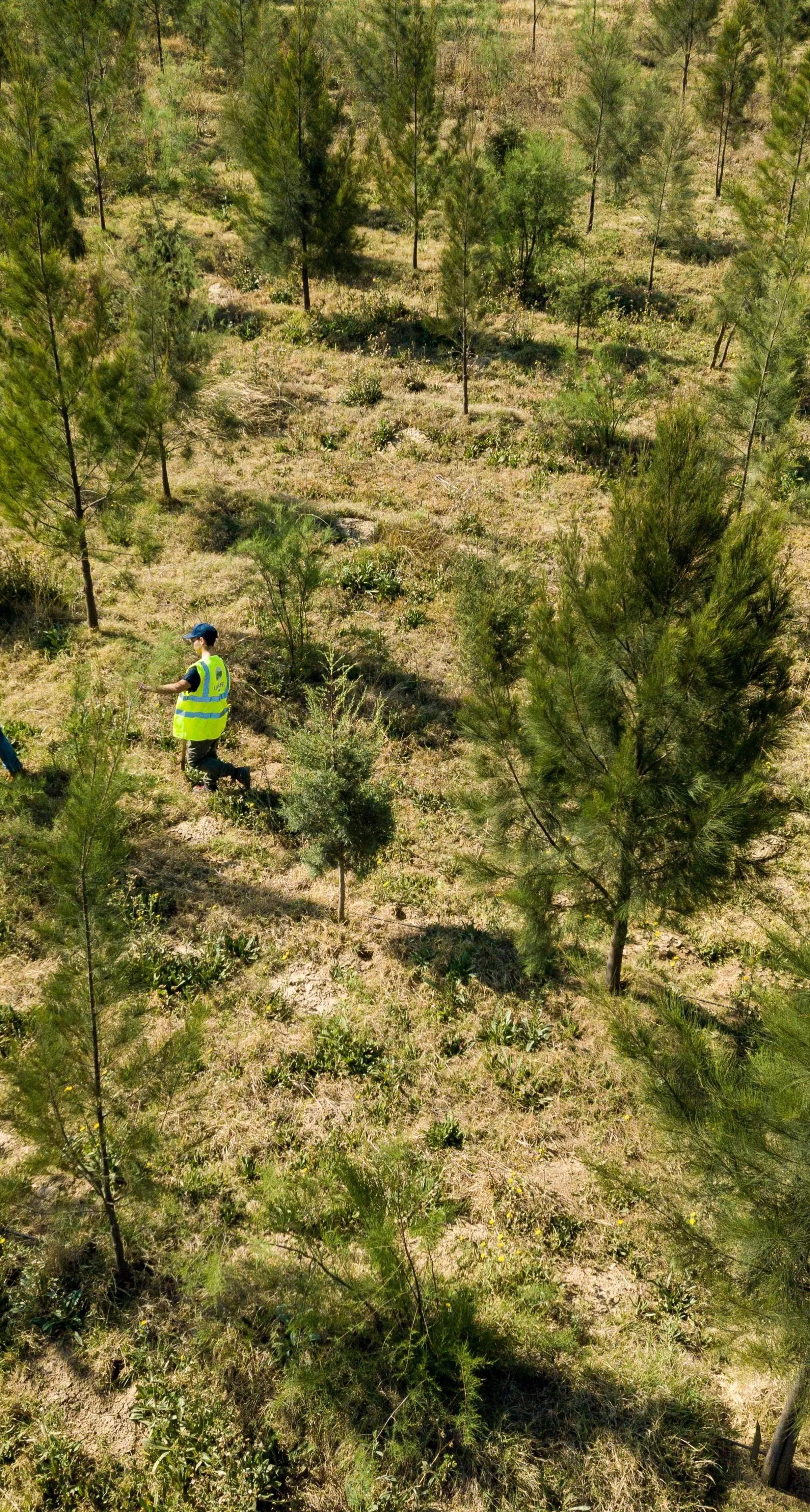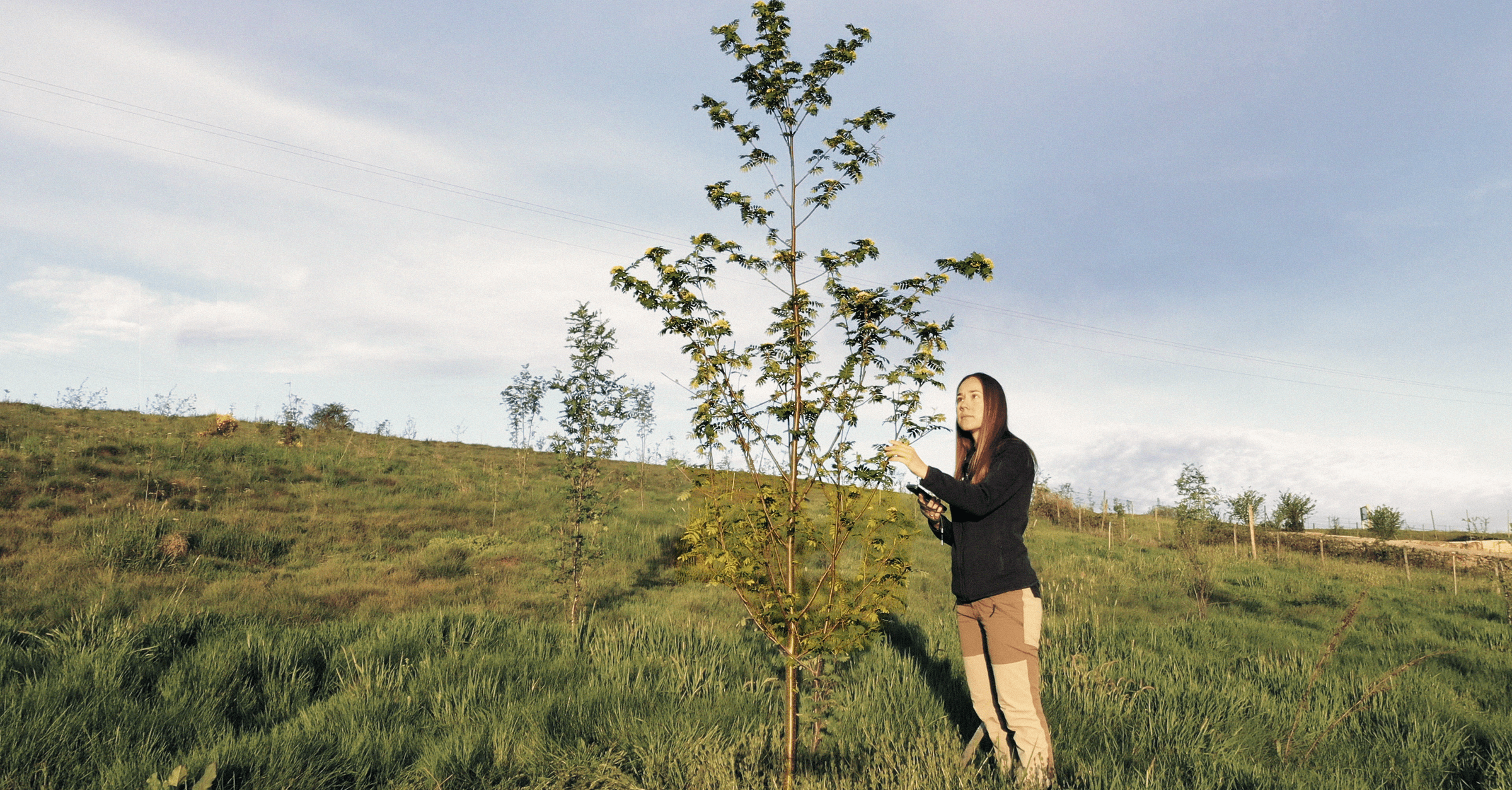Frequently Asked Questions
Find out more about Land Life
FAQ
What does Land Life do?
Land Life is on a mission to restore the world’s 2 billion hectares of degraded land. To achieve this mission, we plant trees – at scale, where nature needs help and use technology as a driver to enable us to grow forests.
We work with partners and landowners in the field – we help them revitalize the land where trees once stood by (co-)designing and planting diverse native species and monitoring the impact over time.
Our customers are companies that have a strong sustainability agenda. We help them turn their carbon footprints into high-impact reforestation projects that grow into resilient forests over time.
What sets Land Life apart from other tree-planting organizations?
We create technology-driven, scalable projects with tangible impact.
Is Land Life a NGO?
No. We are a social enterprise putting our mission of restoring the world’s 2 billion hectares of degraded land above all else. We chose to organize ourselves as a for-profit company in order to stay in control of our own operations and get to decide when, where and how we plant trees.
We chose to be a for-profit company because we believe we are part of an emerging climate sector that requires diverse players from governments to NGOs to companies to work together to tackle climate change.
Is Land Life conducting reforestation or afforestation?
Reforestation is what we do. For context, reforestation refers to planting trees where trees once stood. Afforestation refers to planting trees in an area where forests did not previously exist.
Can I donate or volunteer?
Unfortunately not. We are not set up to manage your well-intended contributions or volunteering. Besides our own planting teams, we work together with local communities in the field.
What kind of technology does Land Life use?
Think drones, satellite imagery, machine learning and monitoring applications. We collect extensive data to track trees’ health and performance so we can get better and better with each planting season.
You can find more detailed information here.
Who are the people behind Land Life?
We are a team of 50 (and growing) based in the Netherlands, Spain, USA and Australia (for now). We come from all backgrounds, spanning the fields of ecology, engineering, remote sensing, software development, business strategy, sales, marketing and design.
Cocoon
What is the Cocoon?
The Cocoon is a biodegradable tree incubator that enables small seedlings to establish in dry and degraded areas. The Cocoon was Land Life’s first innovation and is patented across the globe. Over time, we started developing and deploying additional technology across the reforestation value chain as we became an end-to-end reforestation company.
How can I purchase the Cocoon?
Currently the Cocoon is not being sold
Impact
Why should my company consider reforestation?
Reforestation can help your company compensate for its carbon footprint by actively removing carbon from the atmosphere. But there’s more. In addition, you are:
What impact can I expect from Land Life projects?
Our projects have several positive impacts. These are amongst others, carbon sequestration, climate mitigation, climate adaptation, nature restoration, regenerating biodiversity and benefiting local communities. See the questions below for more detail.
Do your projects support biodiversity?
Yes, absolutely. Restoring and enhancing biodiversity is at the heart of what we do. We plant trees to grow resilient and diverse forests, this in itself enhances biodiversity and over time naturally encourages the growth of other flora and fauna. For example, many of our projects are essential parts of migration corridors for mammals, birds and other animals.
How do local communities benefit from your projects?
Our reforestation projects benefit local communities economically and socially. Unsurprisingly, there is a large overlap between land degradation and lower-income/vulnerable communities. We aim to reverse the land degradation, and in doing so employ and partner with local communities, attracting investments, revitalizing the ecosystem and creating highly skilled jobs, such as Forestry Engineers and Remote Sensing Experts. This is just the beginning, over time nature restoration brings new opportunities, like forest management, ecotourism, etc. Check out our projects for more context.
How do your projects contribute to climate action?
Our projects contribute to climate mitigation, drawing down carbon from the atmosphere, and climate adaptation, making nature more resilient in a changing climate.
For most businesses and organizations, the most tangible overlap with our projects is carbon removals, also called “neutralization,” which help organizations on their journey to reach “Net Zero.”
How does CO2 removal work?
Carbon removal, or “sequestration” removes or diverts CO2 emissions away from the atmosphere and stores the CO2 in “carbon sinks” such as trees or soil organic matter.
Individuals or organizations looking to reduce their carbon footprint can “neutralize” the residual part of their footprint by supporting reforestation. This is where our projects come in. A tree is one of the oldest and most tangible ways of drawing CO2 from the atmosphere. Nature has been doing this for millennia, and you can see the progress as the tree grows.
What is Net Zero and how does it differ from carbon neutrality?
Net Zero is a new chain of thought, refreshing old terminology eg. carbon neutrality. Carbon offsets refer to verified credits matching your carbon footprint on a year-on-year basis. Net Zero is different because first, you understand your impact, aim to reduce this as much as possible, then you invest in or purchase carbon removals and after that, you purchase carbon credits.
The Paris Agreement primarily focuses on carbon reduction, then removal and offsetting as a last resort. This reflects our preference, we ask partners to change internally too. Removing carbon is not a license to emit.
How much carbon does a tree capture?
As a rule of thumb, in the areas that we plant it typically takes between 3-5 trees 40 years to remove a ton of CO2. Of course, not every tree is the same so it does vary slightly based on where we plant, how we plant and which species we plant.
For how long can trees capture CO2?
As trees grow older growth rate is tapering off, implying that overall (net) CO2 capture becomes zero: photosynthesis during day time becomes nullified by respiration at night, as the tree’s canopy also needs to maintain an accumulating amount of it’s biomass in roots, stems and leaves. This differs amongst tree species (e.g. oaks (200-300 yr) generally have a longer lifespan than birch (50-70 yr)) and growing conditions (slower growth in drier and hotter geographies). Additionally, older trees with expanding tree canopies start competing with each other to capture sunlight, while their spreading root systems compete for water and nutrients in the soil. Over time tree growth may also become impaired by pests and diseases.
How does Land Life estimated the sequestered carbon of trees?
Land Life does site specific modelling to determine the carbon sequestration at any given site. We have developed our own model which draws from the national forest inventory (NFI) data. The LLC-FastTrack model is a biometric model based on the IPCC Tier 2 approach and extended for mixed-species stands.
The FastTrack and Allometry models are essentially data driven, statistical models. using available equations and model inputs / parameters. Using these models and data, we can make an estimate of the carbon sequestered at a given site.
We also take into consideration the interactions between different species (the right combination of species can complement each other), the potentially more dynamic climate and the natural mortality rates and regeneration processes) like when making our sequestration projections.
Planting and Land Management
Do I need to pay for the land preparation, the design of the project or the reforestation itself?
No, you don’t have to pay. Land Life will pay for the entire reforestation project, including the soil analysis, design, planting and monitoring.
What makes my land eligible for restoration by Land Life?
We look at each project individually. In general, the following thresholds must be met:
- You must have full ownership rights to enter into an agreement with Land Life
- Your land was at one time forested or has the potential to become a forest.
- If planting trees adds value to what nature can do on its own.
- If there’s no other existing legal obligation to reforest the land.
- The land should not be used or alternatively, the current land use should not be moved elsewhere as a result of the reforestation.
- You should be able to agree to protect the new trees for at least 40 years.
- There should be an average annual rainfall between 600 and 1300 mm.
Where does Land Life plant trees?
Our large-scale plantings take place in Spain, the US and Australia. In these locations, we work to restore severely degraded land. To date, our largest projects take place in Castilla y Leon, in northern Spain, where the land has been degraded by over-farming, wildfires and urbanization.
Additionally, we also have selective iconic projects that focus on a specific community or species in need. For example, we work with UNHCR, the UN refugee agency to regreen a refugee camp in Northern Cameroon, and are planting trees to restore the habitat of the Monarch Butterfly in the Monarch Biosphere Reserve in Mexico.
To find out more about our current and past locations, have a look at our projects.
Why does Land Life choose certain locations?
We plant trees on degraded land. This means we work in geographies where nature cannot come back unaided (a UNCCD definition). To make sure we do not just plant trees, but grow lasting, healthy forests, we only plant in geographies where we can count on local governments, partners and communities to safeguard the planted trees. We invest in hubs around the world to plant season after season so we can learn and research to produce the best possible results.
What is land degradation?
According to the UNCCD “land degradation is a pervasive systemic phenomenon that can take many problematic forms, including chemical contamination and pollution, salinity, soil erosion, nutrient depletion, overgrazing, deforestation, and desertification.”
How does Land Life guarantee permanence?
We prioritize locations that have very strong legal institutions and capable competent partners, these are typically government forestry agencies, community/municipal landowners or private landowners willing to put their land under protective covenant/easement.
We meticulously design planting projects by optimizing the species mix to fit the local terrain and climate. For example, we plant trees that complement each other and don’t compete for water, and specifically design layouts that are more wildfire resistant. We use an in-field monitoring app to monitor each of our projects.
The impact of each project that is measured through technology is visualized and shared with our customers. Land Life has developed a proprietary global reforestation dashboard to enable stakeholders to follow, track, and share the location, story, and impact of the plantings.
Sustainable Business
How can you help my company to take climate action?
Step number one would be to calculate your carbon footprint and reduce that as much as possible. After doing that, our projects can help you remove your residual emissions over time by working together to plant trees and grow forests. CO2 is removed over 40 years, (nature has its own pace!) Over this period, you can also claim that you are creating, rebuilding and regenerating natural ecosystems.
How can my company start planting trees with you?
We first need you to figure out the following three things: what is the carbon footprint you want to compensate for and how many years are you willing/able to commit to the planting program.
Once you know the answers to these two questions, you can reach out to our commercial team.
You can find our contact details here.
Can I, as an individual, start planting trees with you?
We focus on large-scale reforestation projects. As a result, we are not set up to respond to all the wonderful individual inquiries we get.
How does my tree planting contribute to the SDG’s?
Our projects generate a multitude of positive impacts as previously mentioned. These impacts touch many aspects of the UN Sustainable Development Goals (SDG). The most notable ones are:
How do I know that my trees are planted?
We are all about “impact you can see,” so we make sure you can see it. The on-the-ground transformation of your growing forest can be followed on our digital reforestation dashboard, Gaia. Through Gaia, you can see GPS planting coordinates, details about tree species and regularly updated stories from the field as the trees grow.









